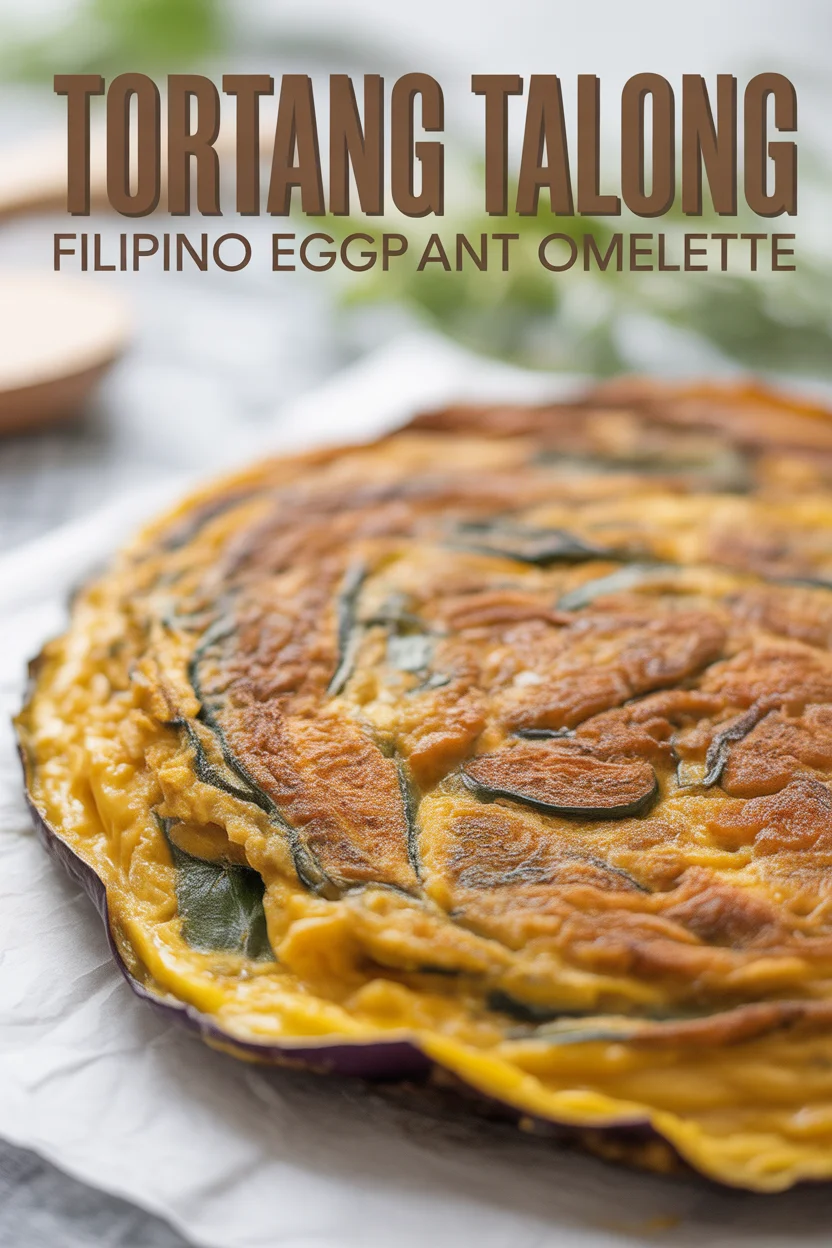- Introduction to tortang talong
- Roasting eggplant
- Preparing egg mixture
- Cooking omelet
- Serving suggestions
- Variations
- Healthy notes
You know that moment on a weekday morning when you open the fridge and, sigh, nothing exciting is staring back at you? Filipino tortang talong is the meal that pulls you out of a breakfast rut. It’s humble — just eggplant, eggs, and pantry basics — but somehow completely magical. Around my house, when I need something warm and homey without needing a culinary degree, this is my go-to (let’s be real, my kids don’t even complain which makes it instantly a five-star restaurant dish in my eyes). Bonus: it’s fun to mash together with other classics, like these kid-friendly Filipino recipes or as a side for your hearty beef caldereta. Trust me, once you learn it, you’ll be making Filipino tortang talong for breakfast, lunch, or those shady late-night munchie attacks.

Introduction to tortang talong
If you’ve never tried Filipino tortang talong before, imagine the best parts of an omelet but with a slightly smoky, melt-in-your-mouth eggplant twist. This recipe is everywhere in the Philippines, especially at cafeteria-style “carinderia” eateries. Why? Everyone loves it! Adults, picky kids, the neighbor who pretends she’s dieting but eats two servings (okay, maybe that’s me). My lola used to make this on rainy afternoons, right when you didn’t even realize you were hungry till that smoky smell wandered from her kitchen.
Honestly, you just take a big Asian eggplant, roast it till collapse, flatten it out, dip it in egg, fry it up, and… wait, that’s it? Yep! That’s the beauty of Filipino tortang talong. Plus, it’s cheap. If you’re craving familiar Filipino flavors and only have a few bucks, you’re set. The real secret? Don’t rush the roasting step. Get the eggplant super soft so you can smush it flat. Egg soaks in and it gets all golden outside, creamy inside. I’ve eaten it with garlic rice, on top of bread (don’t judge till you try), or with ketchup in a pinch.

Roasting eggplant
Roasting is, no lie, my favorite part. You get to burn stuff on purpose. For Filipino tortang talong, roasting gives the eggplant that smoky flavor you’ll daydream about later. Here’s a quirky tip: if you’ve got a gas stove, just plop that eggplant directly on the burner and turn it with tongs. Char all sides till black—and yeah, it will look a little apocalyptic. If you’re more civilized, you can also use a broiler or even toss it on a grill outside.
You’ll know it’s ready when the skin is super wrinkly and the eggplant feels floppy, almost like an overcooked hotdog. Let it cool a bit (seriously, don’t peel while it’s steaming–big mistake) then strip off the skin. Keep the stem so you’ve got a handle, and gently flatten out the flesh with a fork. Nothing fancy, seriously. You want it kind of splayed out, like a wide paddle. That’s what helps soak up all the egg in the next step. Sometimes the eggplant breaks or looks messy. Don’t stress, it fries up just fine and tastes the same!

Preparing egg mixture
Alright, let’s chat about the eggy bit. Some fancy folks separate yolks and whites or throw in heavy cream, but me? Two or three eggs (depends how big your eggplant is), a sprinkle of salt and pepper, plus maybe a dash of fish sauce if you want some real Filipino kick. Sometimes I toss in chopped tomatoes, onions, and yeah, a dab of minced garlic if I’m feeling extra. Add green onions? Legit.
Crack your eggs in a bowl, season ‘em well, and give everything a good whisk. Your goal: fluffy eggs with just enough seasoning. The egg is gonna get soaked up by the eggplant, so make sure there’s plenty for coverage. No need to overthink. If you’re making a bunch, just do everything in a big dish and dunk each flattened eggplant in one at a time. Makes your life easier, promise.
Don’t try to do this with cold eggs straight from the fridge. They don’t mix as nicely and honestly, that’s just not pleasant on your hands when you dip the eggplant in.
Cooking omelet
Now comes the fun – frying! Heat a nonstick (or well-oiled) skillet over medium heat. If you’ve got some extra pork fat, use it for a real Filipino flavor boost – but plain vegetable oil works too. Slide the egg-coated eggplant carefully onto the hot pan, then pour a little extra egg mixture around it if you’ve got leftovers. Let it cook without moving it for about two, maybe three minutes, until the bottom turns gold and has those lacy edges.
Carefully flip the whole thing over – if you mess up and it breaks apart, it’ll still taste great, I promise. Give the other side a couple more minutes till it’s nice and set. If the pan’s too hot, the omelet gets tough, so medium is the way to go. Some folks stack two eggplants in the same frying pan, overlapping a bit, but I say one at a time gets crispier results.
The first time I tried flipping my Filipino tortang talong, the whole thing folded up like a sad pizza slice. Eventually, you get a feel for it. You can tuck in any loose pieces with a spatula or, just accept “rustic” as your style (that’s what I do).
“I used to think tortang talong was hard, but this way made it super simple! My husband requests it every Sunday. Total game changer for breakfast.” – Marilou, LA
Serving suggestions
What’s the best way to eat Filipino tortang talong? Here’s how we love it in my house (and honestly, give each one a go):
- Over hot garlic rice: Perfect for breakfast or lunch with a splash of banana ketchup.
- Next to classic silog combos: I’ll even toss a fried egg on the side, double eggs, why not.
- Stuffed inside a sandwich: Seriously, between pan de sal with a bit of cheese, it’s wild.
- Topped with sautéed ground pork or beef: You’ll never look at omelets the same way again.
If you want to round out the meal, serve with a bright side salad or as part of a healthy Filipino dinner. Though honestly, I’ll eat it solo straight out of the pan, crouched over the kitchen counter. No shame!

Variations
Filipino tortang talong is that one friend who gets along with everyone. You can dress it up or down depending on your mood (or what’s left in your fridge). Add ground pork and call it “rellenong talong”—that’s like a whole meal. Add chopped tomatoes, chilies, even grated cheese for a gooey finish, why not? For a twist, swap regular eggs for duck eggs (it’s richer and kinda fancy). If you eat plant-based, you can sub the egg with chickpea flour batter and, you know, make your vegan auntie happy at reunions.
Sometimes my cousin drops in crispy dilis (little dried fish) for crunch. I even saw someone slathering it with mayo and sriracha which, not gonna lie, blew my mind. Filipino tortang talong really does not judge your hunger pang creative experiments! Just be bold and riff away.
Healthy notes
Let’s talk health for a sec. Filipino tortang talong is mostly eggplant and eggs – both full of protein, vitamins, and goodness. If you use plenty of oil, yeah, it gets richer, but you can also cook it with less for a lighter version (I use a nonstick pan when I’m pretending to watch calories). Got high blood pressure? Skip the extra salty fish sauce and just add a squeeze of calamansi or lemon at the end for flavor.
Eggplant is super low in calories but high in fiber. Eggs give you energy to tackle work, chores, or chasing children. Even better, this dish can be gluten-free if you skip the sandwich bit. Not bad right? You can find even more healthy Filipino ideas over at these nutrition-forward recipes. I swear it fills you up without feeling too heavy.
Bottom line: Filipino tortang talong is hearty enough for a main, light enough for a snack, and healthy enough not to feel guilty when you eat two helpings.
If you’re hunting for even more inspiration or need a second opinion (because why not triple-check, right), I’ve found legit tips and tweaks from Filipino home cooks like on Iankewks and the breaking-down-every-step style from Serious Eats, plus this homey Food52 classic. Seriously, once you learn this simple omelet, you’ll totally get why Filipino tortang talong is such a beloved staple from Baguio down to Davao.
Filipino Tortang Talong
Ingredients
Main ingredients
- 1 large Asian eggplant Roasted until soft
- 2-3 large eggs Dependent on size of the eggplant
- 1 pinch salt To taste
- 1 pinch black pepper To taste
- 1 dash fish sauce Optional for additional flavor
Optional additions
- 1/2 cup chopped tomatoes For added flavor
- 1/2 cup onions Chopped
- 1 clove minced garlic Optional addition
- 1 2 tbsp green onions Chopped
Instructions
Roasting eggplant
- Roast the eggplant on a gas stove, broiler, or grill until the skin is black and wrinkly, and the eggplant feels soft.
- Let it cool, then peel off the skin while leaving the stem intact for handling.
- Flatten the eggplant with a fork to create a splayed shape.
Preparing egg mixture
- In a bowl, crack the eggs and add salt, pepper, and optional fish sauce.
- Whisk the mixture until fluffy and well combined.
Cooking omelet
- Heat a nonstick skillet over medium heat, adding oil or pork fat if desired.
- Carefully place the egg-coated eggplant in the skillet and pour additional egg mixture around it.
- Cook for 2-3 minutes until the bottom is golden.
- Flip the omelet carefully and cook for another couple of minutes until set.
Serving suggestions
- Serve over hot garlic rice, as part of silog combos, or stuffed inside a sandwich.

